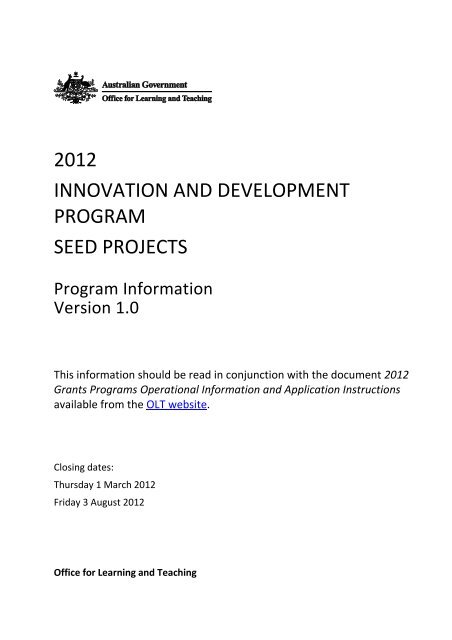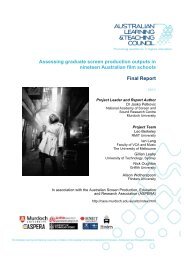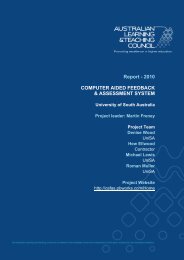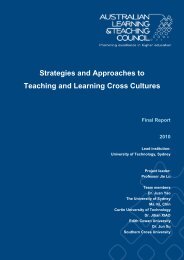2012 innovation and development program seed projects - Office for ...
2012 innovation and development program seed projects - Office for ...
2012 innovation and development program seed projects - Office for ...
- No tags were found...
You also want an ePaper? Increase the reach of your titles
YUMPU automatically turns print PDFs into web optimized ePapers that Google loves.
<strong>2012</strong>INNOVATION AND DEVELOPMENTPROGRAMSEED PROJECTSProgram In<strong>for</strong>mationVersion 1.0This in<strong>for</strong>mation should be read in conjunction with the document <strong>2012</strong>Grants Programs Operational In<strong>for</strong>mation <strong>and</strong> Application Instructionsavailable from the OLT website.Closing dates:Thursday 1 March <strong>2012</strong>Friday 3 August <strong>2012</strong><strong>Office</strong> <strong>for</strong> Learning <strong>and</strong> Teaching
Contents1. ABOUT THIS PROGRAM 11.1 Program priorities 11.2 Program funding 11.3 Funding ranges <strong>and</strong> project duration 11.4 Program in<strong>for</strong>mation review 12. INNOVATION AND DEVELOPMENT PROGRAM 21.1 Introduction 22.2 Program objectives 22.3 Program priorities 22.4 General supporting in<strong>for</strong>mation 42.5 Other useful material 53. PROGRAM CRITERIA 63.1 Overlap with other <strong>program</strong>s 63.2 Eligibility 63.3 Criteria 63.4 Consolidation of previously funded <strong>projects</strong> 73.5 Project leaders <strong>and</strong> project teams 73.6 Budget items <strong>and</strong> purpose of grant 8<strong>Office</strong> <strong>for</strong> Learning <strong>and</strong> Teaching<strong>2012</strong> Innovation <strong>and</strong> Development & Seed Projects Program In<strong>for</strong>mation ii
1. ABOUT THIS PROGRAMThe Innovation <strong>and</strong> Development Program supports research, <strong>development</strong> <strong>and</strong> <strong>innovation</strong> related tothe enhancement of learning <strong>and</strong> teaching in higher education.1.1 Program prioritiesThere are two rounds of applications in <strong>2012</strong>, each addressing different priorities.Round 1 (closing date 1 March <strong>2012</strong>)• Assessment <strong>and</strong> promotion of student learning• Strategic approaches to learning <strong>and</strong> teaching which enhance student access <strong>and</strong> progression, <strong>and</strong>respond to student diversity• Internationalisation• Research <strong>and</strong> <strong>development</strong>Round 2 (closing date 3 August <strong>2012</strong>)• Curriculum renewal• Improving tertiary pathways• Innovation <strong>and</strong> <strong>development</strong> in learning <strong>and</strong> teaching, including in relation to the role of newtechnologies• Research <strong>and</strong> <strong>development</strong>• InternationalisationApplications <strong>for</strong> Seed Projects will also be accepted in this <strong>program</strong>. Seed Projects are pilot <strong>projects</strong>which test <strong>and</strong> evaluate an original idea. Original ideas are understood to be any which have notalready been funded by one of the OLT's predecessor organisations, or by an institution. Applicationscan address any of the priorities in this <strong>program</strong>, or in the Leadership <strong>for</strong> Excellence in Learning <strong>and</strong>Teaching Program, or any other topic.1.2 Program fundingInnovation <strong>and</strong> Development: $4.0 million (indicative).Seed Projects: $1.0 million (indicative). (Please note this funding also covers Seed Projects funded underother <strong>program</strong>s.)1.3 Funding ranges <strong>and</strong> project durationSeed Projects will be funded to a maximum of $50,000. Duration: up to one year.Applications building directly on completed <strong>projects</strong> funded by OLT's predecessor bodies have a fundingrange of $50,000–$150,000. Duration: up to two years.For applications other than those building directly on previous work, there are two funding ranges:$50,000–$220,000, <strong>and</strong> $220,000 <strong>and</strong> above. Applicants may specify the duration of these <strong>projects</strong>.Applications <strong>for</strong> funding of $220,000 <strong>and</strong> above must propose large, national <strong>projects</strong>, engaging anumber of higher education institutions. Participation of accreditation bodies <strong>and</strong>/or councils of deansis strongly encouraged.The OLT reserves the right to ask <strong>for</strong> a proposal to be modified <strong>and</strong>/or re-submitted <strong>for</strong> decision.1.4 Program in<strong>for</strong>mation reviewJune <strong>2012</strong>.<strong>Office</strong> <strong>for</strong> Learning <strong>and</strong> Teaching <strong>2012</strong> Innovation <strong>and</strong> Development & Seed Projects Program In<strong>for</strong>mation 1
2. INNOVATION AND DEVELOPMENT PROGRAM1.1 IntroductionThe Innovation <strong>and</strong> Development Grants Program is one of the OLT's major grants <strong>program</strong>. Details ofthe other grants <strong>program</strong>s can be found at URL.Be<strong>for</strong>e submitting a grant proposal to the OLT, prospective applicants should familiarise themselves withthis document <strong>and</strong> the document <strong>2012</strong> Operational In<strong>for</strong>mation <strong>and</strong> Application Instructions <strong>and</strong> thedraft funding agreement (which is available at the OLT website). Applicants are responsible <strong>for</strong> ensuringthat their proposals are complete <strong>and</strong> accurate.There will be two calls <strong>for</strong> proposals in <strong>2012</strong>. Only applications addressing that round's priorities will beaccepted. The OLT reserves the right to ask <strong>for</strong> a proposal to be modified <strong>and</strong>/or re-submitted <strong>for</strong>decision.2.2 Program objectivesThis <strong>program</strong> has the following objectives:(a) promote <strong>and</strong> support strategic change in higher education institutions <strong>for</strong> the enhancement oflearning <strong>and</strong> teaching, <strong>and</strong> the benefit of the student experience(b) raise the profile <strong>and</strong> encourage recognition of the fundamental importance of teaching in highereducation institutions <strong>and</strong> in the general community(c) develop effective mechanisms <strong>for</strong> the identification, <strong>development</strong>, dissemination <strong>and</strong> embedding ofgood individual <strong>and</strong> institutional practice in learning <strong>and</strong> teaching in Australian higher education(d) develop <strong>and</strong> support reciprocal national <strong>and</strong> international arrangements <strong>for</strong> the purpose of sharing<strong>and</strong> benchmarking learning <strong>and</strong> teaching processes(e) develop <strong>and</strong> enhance a deep underst<strong>and</strong>ing <strong>and</strong> knowledge of the learning process appropriate to thedisciplines being taught.2.3 Program prioritiesRound 1, <strong>2012</strong>• Assessment <strong>and</strong> promotion of student learningApplications should propose an examination of one or more of the following:• <strong>development</strong>al, diagnostic <strong>and</strong> summative assessment <strong>and</strong> feedback to students• assessing postgraduate coursework students• assessing students in practice settings• innovative models of assessment <strong>and</strong> reporting student achievement• <strong>development</strong>s which build on completed predecessor bodies' <strong>projects</strong> related to studentassessment• assessment moderation <strong>and</strong> benchmarking• Strategic approaches to learning <strong>and</strong> teaching which enhance student access <strong>and</strong> progression, <strong>and</strong>respond to student diversityApplications should propose to develop <strong>and</strong> model approaches to learning <strong>and</strong> teaching whichenhance student access <strong>and</strong> progression, through a direct response to student diversity: applicantsshould not assume that <strong>projects</strong> addressing students are, by implication, addressing ‘studentdiversity’.<strong>Office</strong> <strong>for</strong> Learning <strong>and</strong> Teaching <strong>2012</strong> Innovation <strong>and</strong> Development & Seed Projects Program In<strong>for</strong>mation 2
Applications addressing support <strong>for</strong> Indigenous students, Indigenous teachers <strong>and</strong>/or the teachers ofIndigenous students are particularly encouraged as are <strong>projects</strong> addressing the needs of studentsfrom a low-SES background.• InternationalisationApplications should propose to develop <strong>and</strong> model the effective integration of international <strong>and</strong>/orintercultural dimensions into teaching <strong>and</strong> learning practice <strong>and</strong> address key issues such as:• assessment practices in the context of internationalisation• curriculum design• intercultural competency• learning support (including language support)• transnational education• Research <strong>and</strong> <strong>development</strong>A small percentage of funding will be reserved <strong>for</strong> applications which address an issue not featured inthe other priorities but considered by the St<strong>and</strong>ing Committee to be of national significance oraddressing a major concern in a discipline area.ROUND 2, <strong>2012</strong>• Curriculum renewalApplications should propose to develop <strong>and</strong> model contemporary curricula that meet student <strong>and</strong>employer needs <strong>and</strong> provide the basis <strong>for</strong> ongoing personal <strong>and</strong> professional <strong>development</strong> <strong>for</strong>studentsCurriculum <strong>development</strong>/renewal proposals should integrate content-focussed discipline<strong>development</strong>s with learning <strong>and</strong> teaching <strong>innovation</strong>s <strong>and</strong> address key issues such as:• the future direction <strong>and</strong> coverage of <strong>program</strong>s of study• re-positioning or re-shaping of discipline-based courses• revision of assessment practices in the context of curriculum <strong>development</strong>• promotion of cross- inter- or trans- disciplinary <strong>program</strong>s <strong>and</strong> pedagogies• use of in<strong>for</strong>mation <strong>and</strong> communication technologies• inclusivity• the evolution of the teaching model from first to final yearWhile <strong>projects</strong> may develop new <strong>innovation</strong>s where appropriate, emphasis should be given to thecreative application of existing <strong>innovation</strong>s in learning <strong>and</strong> teaching in higher education <strong>and</strong> shouldbe of value to the sector or groups of institutions within the sector. Proposals should includeemphasis on the long-term sustainability of the curriculum renewal process.Projects submitted under this priority could include aspects of the priority Assessment <strong>and</strong>promotion of student learning.Projects arising from the work undertaken in the discipline scoping <strong>projects</strong> are encouraged.• Improving tertiary pathwaysApplications should propose to develop <strong>and</strong> model strategies <strong>for</strong>:• maximising the outcomes <strong>for</strong> students engaging in transition between the vocational educationsector <strong>and</strong> the higher education sector, or• developing <strong>and</strong> modeling <strong>program</strong>s that work with schools to improve participation in highereducation, or<strong>Office</strong> <strong>for</strong> Learning <strong>and</strong> Teaching <strong>2012</strong> Innovation <strong>and</strong> Development & Seed Projects Program In<strong>for</strong>mation 3
• pathways to professional qualifications or to other postgraduate study• Innovation <strong>and</strong> <strong>development</strong> in learning <strong>and</strong> teaching, including in relation to the role of newtechnologiesApplications are not restricted to the use of new technologies: those applications that do engagewith new technologies must include a one-page design brief (see <strong>2012</strong> Grants Programs OperationalIn<strong>for</strong>mation <strong>and</strong> Application Instructions, section 5.5). While <strong>projects</strong> may develop <strong>innovation</strong>s,emphasis may also be given to the creative application <strong>and</strong> <strong>development</strong> of existing <strong>innovation</strong>s inlearning <strong>and</strong> teaching in higher education.Applications rethinking teaching <strong>and</strong> learning in a cyber environment are welcomed.• InternationalisationApplications should propose to develop <strong>and</strong> model the effective integration of international <strong>and</strong>/orintercultural dimensions into teaching <strong>and</strong> learning practice <strong>and</strong> address key issues such as:• assessment practices in the context of internationalisation• curriculum design• intercultural competency• learning support (including language support)• transnational education• Research <strong>and</strong> <strong>development</strong> focussing on issues of emerging <strong>and</strong> continuing importanceA small percentage of funding will be reserved <strong>for</strong> applications which address an issue not featuredin the other priorities but considered by the St<strong>and</strong>ing Committee to be of national significance oraddressing a major concern in a discipline area.2.4 General supporting in<strong>for</strong>mationApplicants are strongly advised to familiarise themselves with the resources available at:http://www.altc.edu.au/managing-your-project.Project Design ConsiderationsThe following advice is taken from Jo McKenzie, Shirley Alex<strong>and</strong>er, Carly Harper, <strong>and</strong> Susan Anderson,Dissemination, Adoption & Adaptation of Project Innovations in Higher Education (University ofTechnology, Sydney May 2005) p. xv.The report recommends that project developers:• consider the range of possible methods that might be adopted <strong>for</strong> involving potential users from thebeginning of a project, <strong>for</strong> example⋅⋅⋅collaborative <strong>development</strong> by a strategically selected group of partnersconsultation with potential users at various stages of the process, from initial project design toprototype evaluation, pilot testing <strong>and</strong> cascading to othersinvolvement of potential users in needs analysis related to the intended project• provide support <strong>for</strong> adopters to engage in the learning necessary to adapt, implement <strong>and</strong> evaluatethe project outcomes effectively, <strong>for</strong> example⋅⋅provide implementation guides accompanying the projectprovide case studies <strong>and</strong> exemplars of implementation<strong>Office</strong> <strong>for</strong> Learning <strong>and</strong> Teaching <strong>2012</strong> Innovation <strong>and</strong> Development & Seed Projects Program In<strong>for</strong>mation 4
⋅⋅⋅⋅provide support or training workshops or other eventsprovide consultancy support <strong>and</strong> services from the project teamuse consultative <strong>and</strong> collaborative <strong>for</strong>ms of <strong>development</strong> which enable potential adopters tolearn <strong>and</strong> in<strong>for</strong>m project <strong>development</strong>consider the range of potential adopters of the project <strong>and</strong> use appropriate methods <strong>for</strong>engaging with them, such as through links with disciplinary or cross-disciplinary organisations.The following advice is from Deborah Southwell, Deanne Gannaway, Janice Orrell, Denise Chalmers, <strong>and</strong>Catherine Abraham, Strategies <strong>for</strong> effective dissemination of project outcomes (The University ofQueensl<strong>and</strong> <strong>and</strong> Flinders University, April 2005), p. 8.Projects should:• establish a communication plan that includes regular communication with the project team,institution, stakeholders, the OLT <strong>and</strong> the wider national community• ensure that evaluation is undertaken at multiple points throughout the project <strong>and</strong> is understood<strong>and</strong> reported within an evaluation framework.DisseminationThe Australian Universities Teaching Committee commissioned two reports to provide advice to the onimproving the wider impact of funded <strong>projects</strong>. These reports are available at:.Many of the recommendations from these reports have been have been incorporated into thisdocument. Applicants are advised to familiarise themselves with the Dissemination Frameworksavailable at the URL above.Assessment ReportsAssessment Reports are available at: http://www.altc.edu.au/grants-funding-available. AssessmentReports provide insight into the strengths <strong>and</strong> weaknesses of applications from previous funding rounds.2.5 Other useful materialThis material will be available on the OLT website.• Report on the Proposals <strong>and</strong> Expressions of Interest from the First Call <strong>for</strong> Priority Projects Under the‘Curriculum Renewal’ Priority, 2008 Professor Owen Hicks, 2009. http://www.altc.edu.au/grantsfunding-available#priority-<strong>projects</strong>• What’s happening in Assessment? 2009 ALTC, 2010. http://www.altc.edu.au/resource-whatshappening-assessment-2009-altc-2010<strong>Office</strong> <strong>for</strong> Learning <strong>and</strong> Teaching <strong>2012</strong> Innovation <strong>and</strong> Development & Seed Projects Program In<strong>for</strong>mation 5
3. PROGRAM CRITERIA3.1 Overlap with other <strong>program</strong>sWhen an application meets the criteria <strong>for</strong> another OLT <strong>program</strong> it should not be submitted under this<strong>program</strong>. Applications that address the criteria <strong>for</strong> another OLT <strong>program</strong> will not be accepted under this<strong>program</strong>.3.2 EligibilityUnder the Australian Government Other Grant Guidelines, institutions listed in Table A <strong>and</strong> Table B ofthe Higher Education Support Act (2003) <strong>and</strong> other approved higher education providers receivingplaces under the Commonwealth Grants Scheme are eligible to apply <strong>for</strong> grants. See section 6 of <strong>2012</strong>Operational In<strong>for</strong>mation <strong>and</strong> Application Instructions <strong>for</strong> the list of eligible institutions.3.3 CriteriaProjects to be funded under the Innovation <strong>and</strong> Development Grants Program should demonstrate thefollowing:Project Outcomes <strong>and</strong> Rationale• Clearly articulated outcomes <strong>and</strong> a clear argument demonstrating how the project will address oneof the <strong>program</strong> priorities <strong>and</strong> contribute to the enhancement of learning <strong>and</strong> teaching in highereducationApproach• A strong theoretical framework that is grounded in the literature• A set of strategies which is considered, coherent <strong>and</strong> appropriate to the outcomes the project isdesigned to achieve• An approach that is in general alignment with the commitments of the OLT <strong>and</strong> objectives under 2.2• Alignment between plans <strong>for</strong> the dissemination/embedding of the successful strategies <strong>and</strong>outcomes <strong>and</strong> the project designValue/Need <strong>for</strong> Project• Potential usefulness of the project <strong>and</strong> its outcomes to any of the following:⋅⋅⋅the sector as a wholeparticular kinds of organisations within the sectorthe <strong>development</strong> of national approaches or policies related to learning <strong>and</strong> teaching in highereducation• Ways in which the project both utilises <strong>and</strong> advances existing national <strong>and</strong> international knowledgerelevant to the <strong>program</strong> priorityProject Management• A thorough approach to project management, including a preliminary allocation of responsibilitiesamong the team members.The quality <strong>and</strong> timeliness of the project leader’s previous work funded by predecessor bodies may betaken into account when considering applications <strong>for</strong> funding.<strong>Office</strong> <strong>for</strong> Learning <strong>and</strong> Teaching <strong>2012</strong> Innovation <strong>and</strong> Development & Seed Projects Program In<strong>for</strong>mation 6
Budget• Budget justification appropriate to the project outcomes <strong>and</strong> importance.Further in<strong>for</strong>mation on the assessment process is set out below at 3.6.3.4 Consolidation of previously funded <strong>projects</strong>Projects that build on or extend previous work are encouraged. However, to ensure the quality of work<strong>and</strong> wide participation in the OLT Grants <strong>program</strong>s, applications arising directly from a project funded bya predecessor body will only be accepted if the final report has been available to the sector at least sixweeks be<strong>for</strong>e applications close. Where the original team is proposing to carry work <strong>for</strong>ward, they arestrongly encouraged to include some new team members.3.5 Project leaders <strong>and</strong> project teamsThe project leader(s) must take significant intellectual responsibility <strong>for</strong> the proposed project, its design,conduct <strong>and</strong> results. This requires a serious time commitment (usually at least 20% of the leader’s time).Individuals may not hold the substantive responsibility (e.g. project leader/director/fellow) <strong>for</strong> morethan two externally-funded learning <strong>and</strong> teaching grants concurrently unless the PVC/DVC (Academic)approves a greater commitment <strong>and</strong> provides details of how the time will be allocated to enableindividuals to carry out their responsibilities to the <strong>projects</strong>. While this restriction does not apply toproject team members, care should be taken by individuals not to over commit.The OLT acknowledges that project leaders <strong>and</strong> team members will be required to allocate time to thesuccessful implementation of a project. All project proposals must include a letter from the respectivehead of school/department <strong>for</strong> each team member stipulating support <strong>for</strong> teaching relief or relief fromnormal duties <strong>for</strong> the team member to participate in the project. Letters of support must be includedwhether or not teaching relief or relief from normal duties has been requested from the OLT.Under normal circumstances, applications involving a project leader whose final report is overdue or notof a satisfactory st<strong>and</strong>ard at the time of close of applications will not be accepted. The Chair of theSt<strong>and</strong>ing Committee has the discretion to rule on this matter. (Note this adds to the current statementabove that prevents leadership of more than two <strong>projects</strong> or one fellowship <strong>and</strong> one project).Project teams are encouraged to include one or two early career academics as substantive members ofthe project team.All nominated project team members should be in agreement with the proposal at the time ofsubmission. If it comes to the attention of OLT that nominated team members are not aware of theapplication, the proposal will be deemed ineligible <strong>for</strong> that funding round.Collaborative ProjectsCollaboration between higher education institutions <strong>and</strong>/or relevant other bodies is encouraged.Applications from consortia will need to be submitted under a lead institution which must be a highereducation institution eligible to receive a grant under Australian Government Other Grant Guidelines.The lead institution must ensure each named collaborating institution/organisation has agreed to haveits name put <strong>for</strong>ward as a collaborating institution be<strong>for</strong>e submitting a project proposal. Failure toensure the agreement of named collaborating institutions/organisations may result in the applicationbeing rejected by the OLT.The lead institution must be authorised to act on behalf of all members of the consortia or collaborativegroup, <strong>and</strong> enter into agreements which are binding on them. For the purposes of the application, allconsortia members <strong>and</strong> the lead institution should be clearly identified.<strong>Office</strong> <strong>for</strong> Learning <strong>and</strong> Teaching <strong>2012</strong> Innovation <strong>and</strong> Development & Seed Projects Program In<strong>for</strong>mation 7
Formal collaborations or partnerships must be acknowledged in documentation regarding the project.Collaborating institution(s) will contribute substantially to the project, usually through a project teammember. Where partners are not represented on the project team, a clear rationale should be includedin the proposal to explain this absence. To acknowledge this commitment, project proposals must beendorsed in writing by way of a letter of endorsement from the PVC/DVC (Academic), or equivalent, ofall collaborating/partner institutions be<strong>for</strong>e submission.Single Institution ProjectsIn keeping with the principles of diversity, collaboration <strong>and</strong> high impact, the principles <strong>for</strong> fundingsingle institution <strong>projects</strong> are:• Case studies of an issue, idea or approach of importance to the higher education sector.• The work proposed should be able to be applied within other institutions.• The proposal includes a comprehensive <strong>and</strong> convincing strategy to ensure outcomes <strong>and</strong> projectmaterials take into account different institutional contexts <strong>and</strong> can be applied in those differentcontexts.• A comprehensive plan <strong>for</strong> dissemination to the relevant audiences: sharing has to be embeddedin the conduct of the project.Proposals <strong>for</strong> single institution <strong>projects</strong> should clearly address these principles in addressing theApproach <strong>and</strong> Value/Need <strong>for</strong> the Project criteria.3.6 Budget items <strong>and</strong> purpose of grantThe grant is provided <strong>for</strong> the purpose of achieving the deliverables <strong>and</strong> outcomes of the project <strong>for</strong>which it is approved.Funding may be approved <strong>for</strong> the period specified in these guidelines or the project brief – whichever isappropriate. All <strong>projects</strong> designed to go beyond 12 months will need to produce measurableoutcomes/deliverables in each year of the funding <strong>and</strong> should be designed around stages that haveparticular outcomes/deliverables.The budget can contain provision <strong>for</strong>:• Salaries <strong>and</strong> on-costs. The rate used <strong>for</strong> on-costs should be 28%• Teaching relief – to a maximum of $35,000 per year per institution associated with a project, with aletter of agreement from the relevant head of school• Dissemination activities• Travel associated with the project’s conduct <strong>and</strong>/or dissemination• Technical <strong>and</strong> expert support, evaluation <strong>and</strong> resources essential to the conduct of the project• Remuneration of advisory or reference group members• Up to 10% <strong>for</strong> administration costs <strong>and</strong> overheads• Editing <strong>and</strong> desktop publishing of the final report.The budget should include an allocation of $3,000 <strong>for</strong> attendance at OLT events in the first year of theproject. For those institutions with high cost travel, once this amount is used up the OLT will considercase-by-case applications <strong>for</strong> an additional allowance.<strong>Office</strong> <strong>for</strong> Learning <strong>and</strong> Teaching <strong>2012</strong> Innovation <strong>and</strong> Development & Seed Projects Program In<strong>for</strong>mation 8
Non-approved use of the grantThe grant may not be used <strong>for</strong>:• building works (including the purchase, construction, lease, renovation or fit out of premises)• purchase of motor vehicles• purchase of assets unless in exceptional circumstances specifically agreed to by the OLT in approvingthe grant (this restriction would normally include computers, small digital devices etc which shouldbe provided by the institution/s as a contribution to the project)• travel which is not directly related to achieving the outcomes of the project <strong>for</strong> which the grant wasapproved• general recurrent funding.<strong>Office</strong> <strong>for</strong> Learning <strong>and</strong> Teaching <strong>2012</strong> Innovation <strong>and</strong> Development & Seed Projects Program In<strong>for</strong>mation 9
















